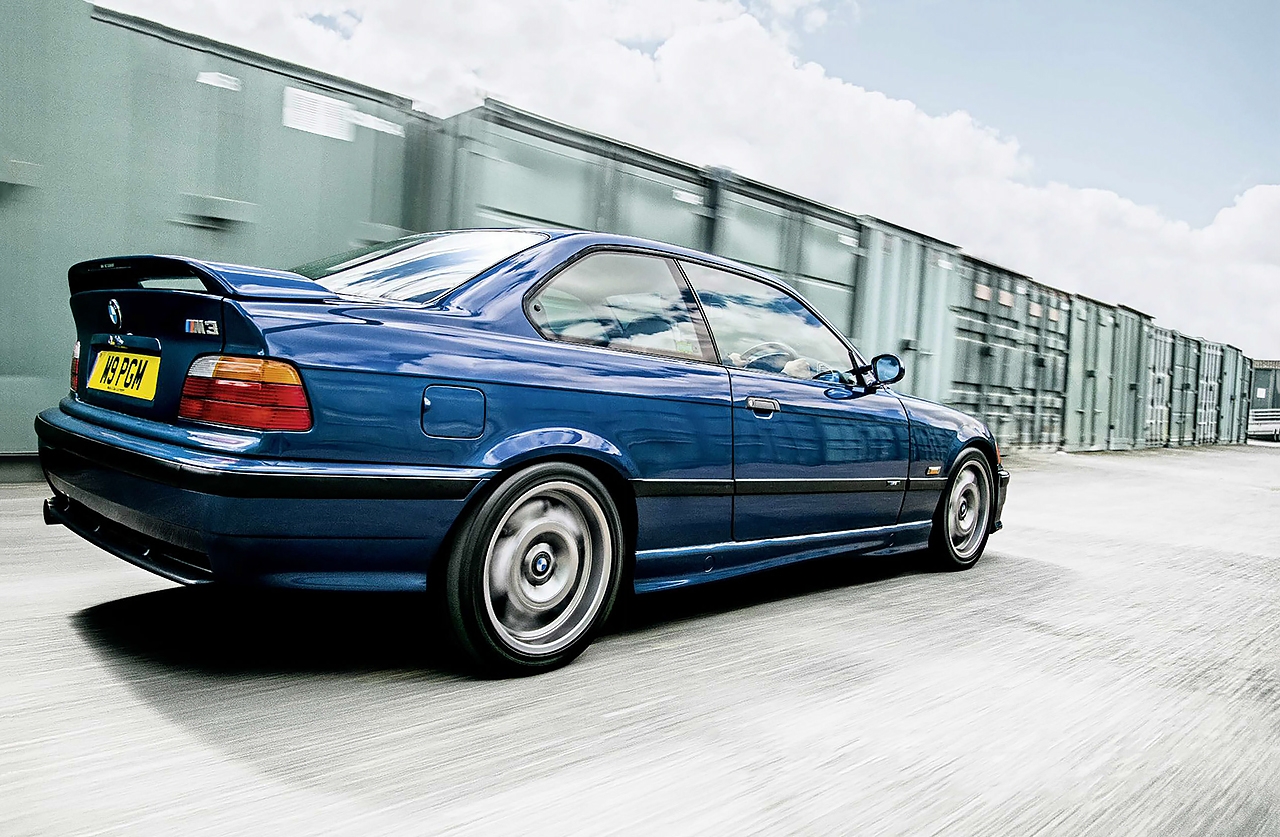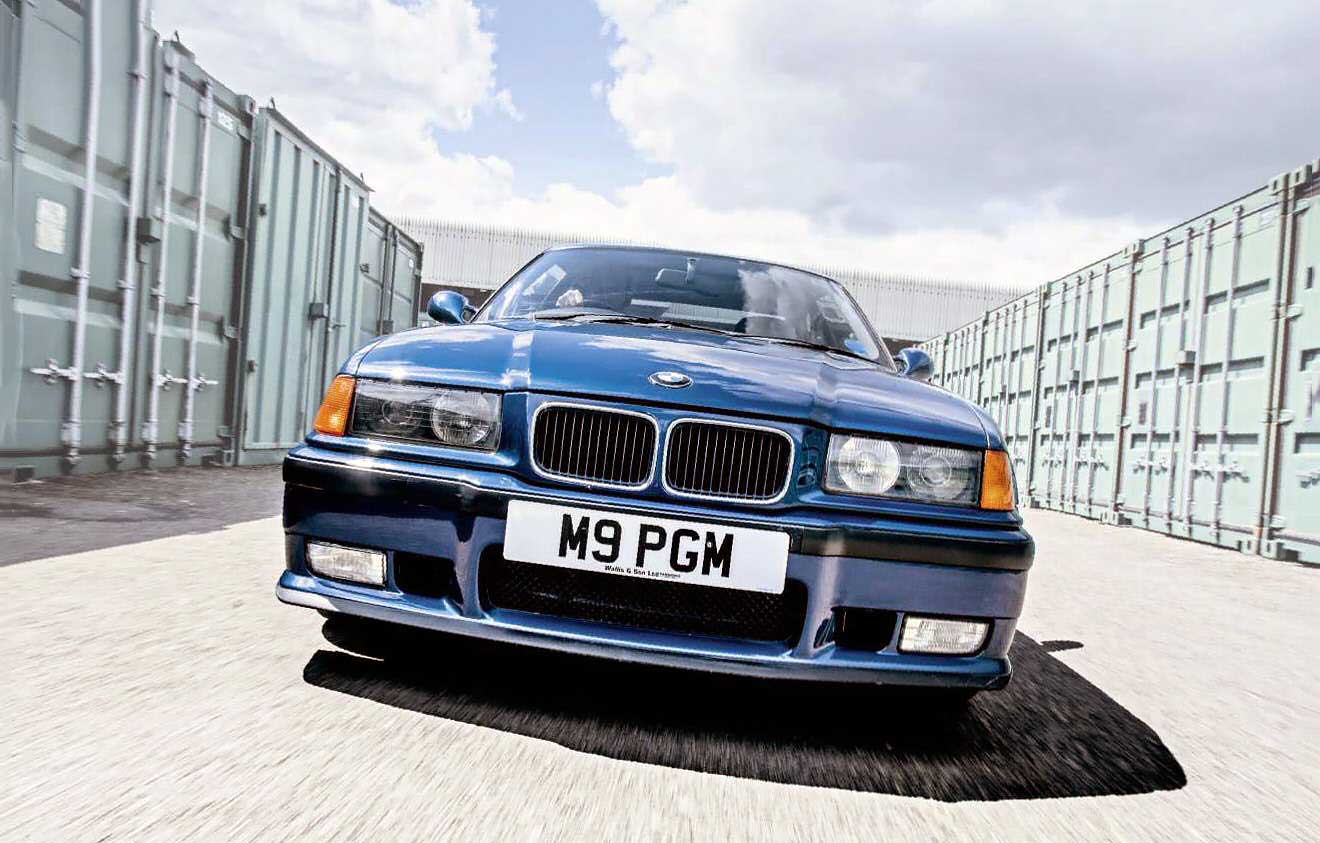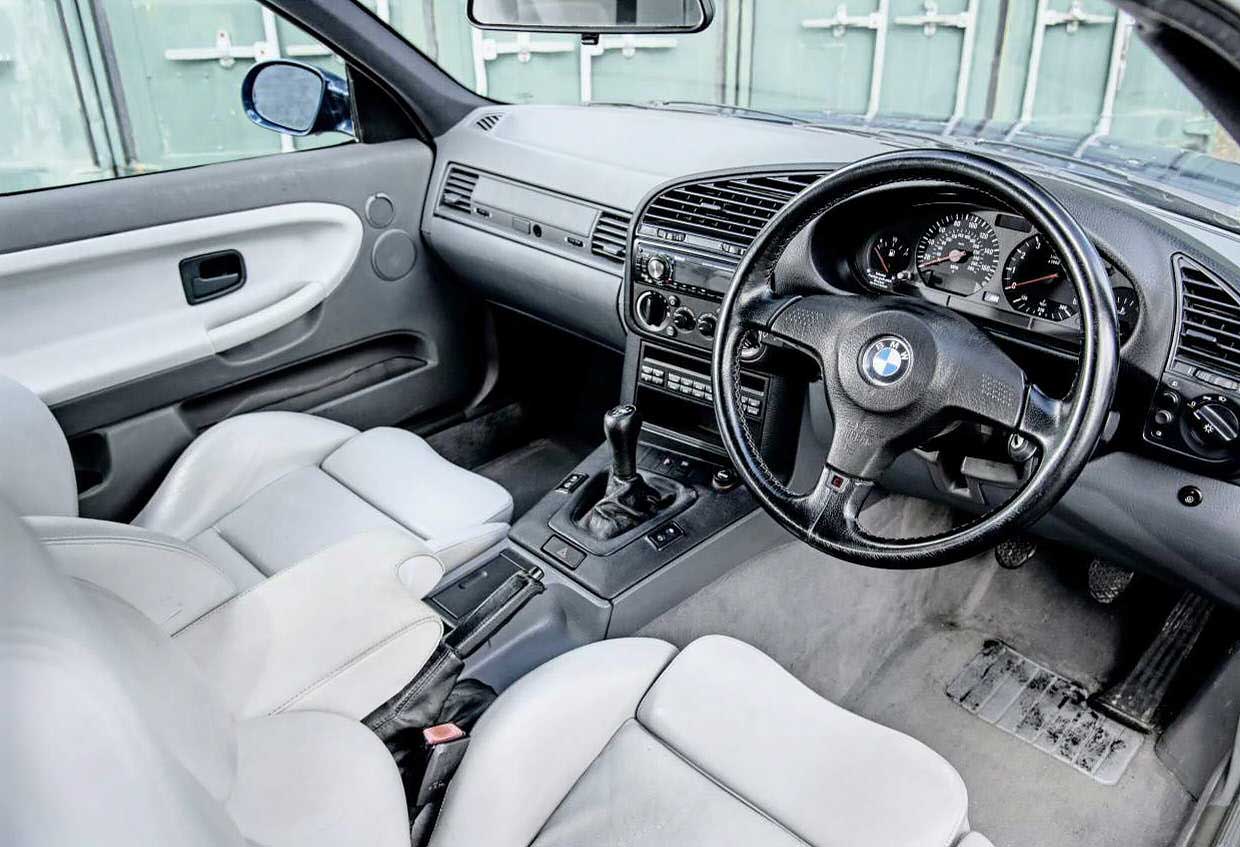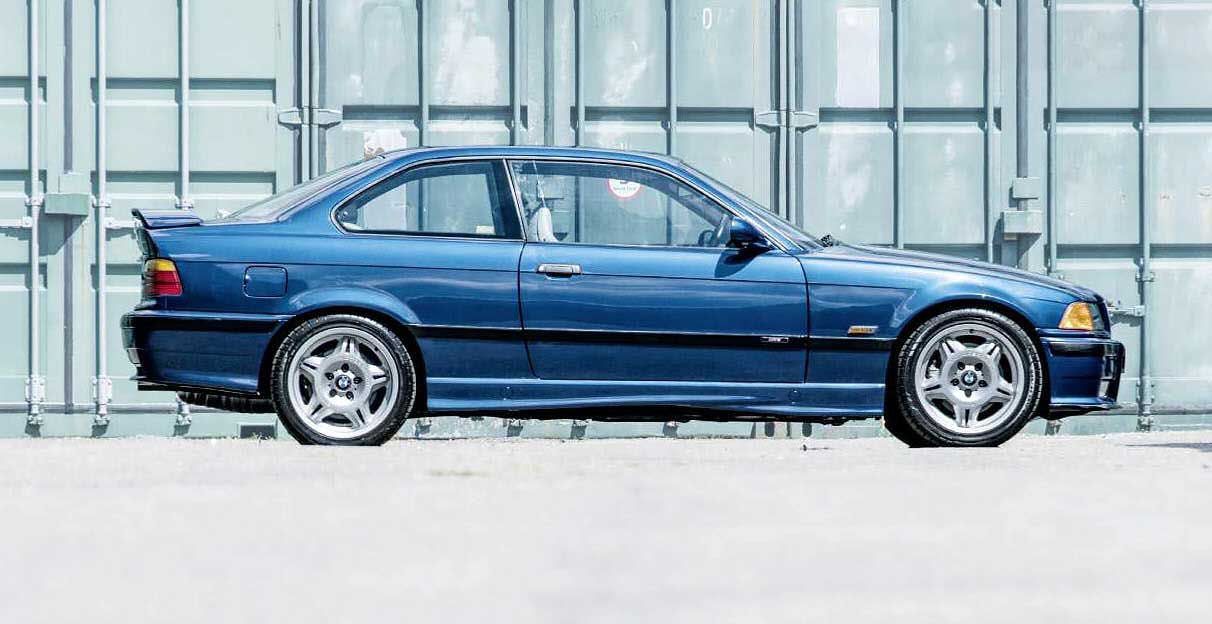
BMW M3 E36 Grab the Munich legend while you still can. The M3 looks better with each passing year. Its time has come. The time is now. Our Clever Money car for this issue is the E36-generation BMW M3, which is sensational to drive, a hoot to own, and will rise in value. For so long the underdog of the BMW M3 dynasty, the E36 is now being recognised as a true Modern Classic. Here’s why you should buy one now, before values climb higher. Words Ben Barry. Photography Jonathan Jacob.
CLEVER MONEY CARS Driving the best automotive bets
Compared with the E30, the E36 BMW is a relatively affordable route to the M3 dream. But perhaps not for long. The second-generation of BMW’s iconic performance coupé was under-appreciated when new, because it was larger and more luxurious than the homologation-special E30 M3 it replaced, more GT than its predecessor’s BTCC.
Until recently E36 values were on the floor at around £3k, while the E30 raced past £20k and, for the rare Sport Evo, towards £100k. This brings the E36 into sharper focus. For the performance on offer, the E36 M3 makes a great case for itself.
With E36 numbers thinning, its depreciation spiral has bottomed out, and values are on the rise. Most cars sit in the £6k-£10k bracket, but tidy low-milers are stretching up to £18k; we’ve seen an exceptional E36 up for £25k. We’re driving this Estoril Blue coupé to remember why the E36 M3 is such a great buy, before values follow the E30’s ascent into unobtainium.
Our 1994 3.0-litre coupé is for sale at Wallis & Son Ltd near Cambridge (wallisandson.co.uk) priced £13,995. Three years ago you’d have had something similar for about a third of that: but that’s where nice examples are now. This one is fully restored with 118,000 miles, a full service history and a good paper trail of old receipts and MoTs. It has nice options too: full leather, rear headrests and armrest, electric sunroof and an M Technic three-spoke steering wheel (with airbag) that replaces the awful standard four-spoker. The rear spoiler looks like a factory option, but could be a close aftermarket match. But enough of drinking in the visuals – time to deploy Munich’s motorway masher.

BMW E36 M3
Turn the ignition key and the 3.0-litre engine settles to a warm, silky hum, but blip the throttle and the revs respond instantly, the hum becoming a metallic rasp as the revs spiral. Your entire focus subconsciously becomes the engine. It defines this car before you’ve even moved away.
The clutch is heavy, and bites early, the gearchange light enough, if a little notchy. If you’d just stepped from an E30, the six-cylinder engine – the sound, the power, the refinement – would be a revelation. But first driving impressions at a cruise do all suggest a lack of driver-focused thrills.
The speed-sensitive power steering has a leisurely ratio, friendly weighting, and doesn’t communicate particularly clearly; the suspension is also quite soft, which underlines the E36’s GT credentials, but robs a certain amount of immediacy and seat-of-the-pants accuracy. It feels like a car designed to hook in those seduced by M Division’s motorsport credentials, but who couldn’t live with a hardcore pseudo racer on the daily commute.
But let the oil temperature needle swing towards the middle of the dial, find some space, and the E36 quickly makes a case for itself. It’s not hugely torquey, but the motor pulls cleanly and smoothly from down low, and it’s muscular enough to make the four-cylinder E30 feel asthmatic. Then there’s a kick at around 5000rpm, and the warm hum is replaced entirely by a metallic fizz from the twin exhaust tips. At this point the M3 starts to gather speed very rapidly indeed.
It feels like a light car being whisked along by a big engine, and you grip the wheel as the speed and noise intensify dramatically.
The E36 M3 was produced as a 286bhp 3.0-litre from 1993-1995 in right-hand drive, after which the 317bhp 3.2-litre Evo came on stream until 1999. Both look similar, but updated 17in alloys, clear indicators and kidney grilles that flare out – rather than recess back behind the bodywork – normally distinguish the Evo. Two decades ago, some complained that the M3 was too hard to distinguish from humbler variants, and every model before or since does feature dramatically different body panels. But the E36’s tightly buttoned-up aggression is exactly what appeals to me – as well as the cheaper replacement panels! – and the larger wheels with wider track, distinctive twin-stalk mirrors, and chunky bumpers, sideskirts and rubbing strips make it impossible to confuse with a 316i. It has a timeless class.
Even when people try to pass of a replica, very few go to the trouble of installing the seats, which remain some of the coolest ever to grace a production car. They’re informally known as Vaders, owing to a supposed resemblance to Star Wars’ dark lord, especially in black.
The seats are positioned quite low to the deck, and the cabin’s clean design wears its years lightly. The instrument binnacle sweeps elegantly into a large central air vent, which curves down into a centre console angled subtly towards the driver. It’s divided into radio/cassette, climate controls – yes, there is air-con – and a button-fest of an onboard computer. The dials are clear, back-lit orange, and an oil temperature dial is neatly integrated into the bottom of the rev counter. Everything feels solid, sumptuous, and of high quality: your elbow sinks into that optional plush armrest, and the handbrake and gearknob are all wrapped in thick, stitched leather. It’s a plush and cossetting place to be. Four adults could watch in comfort from here as you terrorised a Porsche on the autobahn.
Rumour has it that the early cars didn’t have speed limiters, but beyond 140mph, the front end starts to go light and wander, sapping the driver’s confidence. Is it that the optional rear spoiler contributes to the loss of front-end stability, or could it be that it just feels light compared with the later E46 model?
The E36 was the last M3 to be offered without traction control, and the stats – 286bhp and 1460kg – make you wonder if it might be a handful, but the power delivery, the broad tyres, and the relatively longtravel throttle mean you’re unlikely to stress the traction unless the surface is particularly greasy.
But you might when you push harder. There’s such a frenzy of revs and performance by 6500rpm that instinct tells you to shift, and mostly you do, but that’s a shame because the best is yet to come. You need to concentrate and hold your nerve to get there, and it doesn’t sound like such a leap, but pushing the motor just a little bit beyond takes it into another dimension. The revs scream and waver almost hysterically, you fear something’s going to explode, and when you do hit the limiter, it’s like standing inside a fire alarm such is the aural intensity. Doing that on track, with the rear tyres sliding as the LSD locks up and the revs spike – but rarely clip the limiter, such is the headroom – is deeply satisfying, the power curve as orgasm, the ultimate driving machine ethos encapsulated in a few milliseconds of hedonism. An E30 M3 cannot compete with this.
This powerplant remains a classic that genuinely stands up there with the naturally aspirated greats from Porsche, even Ferrari. But diehards argue furiously which is best: 3.0- or 3.2-litre. The 3.0-litre features single VANOS for variable-valve timing on the inlet cam, and is trouble-free. The 3.2 Evo gets double VANOS, which is famously trouble-prone, though the very knowledgeable Roy Bendy, of specialist Eclipse Car Sales, counters that ‘if I sold 100, you’d have a problem with two.’
Both are great, but most drivers prefer the 3.0-litre: it’s a little slower, fractionally smoother than the 3.2 Evo, and its five-speed gearbox glosses between ratios where the Evo’s six-speeder is a bit more arthritic. Nevertheless, Roy says most want the Evo.
The E36 ditched the E30’s trailing arm rear suspension for a multi-link set-up, and there are nuanced chassis set-up diferences between the 3.0 and 3.2 litre, but both retain the same relatively soft feel. Push on hard down a twisty road and there’s no doubting that the E36 lacks the deft communication skills of the E30. The supple suspension is prone to body roll, and although grip levels are high, when the rear does let go, it tends to go quite quickly and without much progression. Then you back of the accelerator in a panic and the soft suspension tries to pitch you into an arm-flailing tank-slapper.
Originality is desirable, but this is one case where a coilover kit is worth the investment. With something like Variant 3 KWs, you get higher traction limits and firmed up the body control, making the E36 much more playful and confidence inspiring.
You can slide it and make it dance and feel much more at one with it than a standard car. It’s more fun and quicker round a track than the standard car too.
If you want a good road car, that’s all you need do. If you want the ultimate track machine, you might become frustrated by the slippery leather that doesn’t offer enough support when you thread together a set of corners, and the so-so brakes. Fit fixed bucket seats and six-piston brakes along with uprated suspension and you have a brilliant driver’s car, and all for far less than the tattiest E30. Better still, an E30 M3 wouldn’t see which way you went, and an E46 driver would have a fight on his hands.
For far too long, the E36 M3 has been criminally under-appreciated by enthusiasts. This is changing. You need to buy one now before values climb any higher.
I BOUGHT ONE BEN BARRY
I need to declare a vested interest here, for I am something of an E36 M3 obsessive. I’ve owned my 1993 3.0-litre coupé since 2001, when I bought it with 155k miles; I’ve also owned a 1997 3.2-litre M3 Evo saloon. I turned my coupé into a track car around 2005, since when it’s been tracked in the UK and Europe, and even raced to a first and second-in-class on a couple of occasions in the Trackday Trophy. It’d covered 215k trouble free miles by the time I tried to qualify it at Donington in 2011 and suffered oil starvation, damaging the bottom end. It was a tired old engine, but these are tough units and the smaller, dual pick-up sump from the later 3.2 would probably have saved it. Now it’s being rebuilt I’m eagerly anticipating the adrenaline hit it’ll provide once more.
‘When you do hit the limiter it’s like standing inside a fire alarm such is the aural intensity’
‘The revs respond instantly, the hum becoming a metallic rasp as the revs spiral. Your entire focus subconsciously becomes the engine’
Buying a BMW E36 M3
If our road test has sparked your interest in snapping up an E36 M3 before too many others cotton on, these are the vital things to know first.
BMWs nowadays go through a similar lifecycle as fast Fords of old. Once out of the hands of the first few owners, they’re modified, thrashed, crashed and often die, unloved and riddled with tin worm. Just look what’s happened with E30 3-series and the E28 and E34 5-series.
They’ve either been driven into the ground or driven into trees, wearing questionable bodykits. The cars that are left, and aren’t perforated by many years of salted winter roads, are now seeing prices rising rapidly, even for run-of-the mill variants. The E36 is only just emerging from its time in the cheap rear-wheel drive car doldrums.
We shouldn’t be that surprised. Though contemporary road tests complained that the E36 M3 had lost some of the hardcore immediacy of the E30, time has treated it well. Just look at the devotion it instilled in Ben Barry over the past few pages. OK, so he’s an enthusiast, but even for those hitherto unconvinced by the cult of M Power, the E36 M3 is worth an extended sampling session.

But it’s best to get that done sooner rather than later, as prices are finally on the march upwards. Good, well maintained cars are now scarce, and the very best are breaching the £15,000 ceiling and touching £25,000 for pristine, concours examples. Bargains can still be had, but there are lots of abused M3s out there. Sifting through them takes care, patience and informed knowledge, so we’ve lined up the factors you need to take into account before pulling the trigger on a prospective M3 purchase.

BMW E36 M3 interior RHD
ESSENTIAL CHECKS
The rear damper top mounts and rear trailing arm bushes often wear. Move the car up and down via the rear arch to spot any odd movement or play around the damper. If the car feels wallowy during the test drive, this could be a tell-tale sign. It is possible to DIY fix – bimmer-forums. com has a guide. The lower control arm bush on the front can also wear, causing wayward handling and uneven tyre wear.
The 3.0-litre M3s have a single VANOS unit, the Evos have two. Issues arise at around 45,000 miles. Piston seal failure, intake gear growling, solenoid/seals failure, snapped pistones and solenoid cover bolts shearing can all be indicated by rough idle and a lack of power throughout the rev range, particularly below 4000rpm. Mr Vanos (mrvanos.com) can provide everything from kits to complete refurbs and rebuilds. The common cause is leaking solenoid seals and independent specialists can fix these for around £250. BMW main dealers will charge significantly more.
The exhaust system can rot at the front and rear, where they’re attached to the exhaust pipe. OEM parts are expensive, though non-OEM stainless steel ones are available. The flexi on the manifold is prone to splitting.

BMW E36 M3
Rust can be an issue on the E36. Thanks to a design fault the inner lip collects water and rots from the inside out. Check areas around the bodykit too, as the metal clips rust. A telltale sign is misaligned body mouldings. The rear wheelarches merit attention, as does the area behind the number plates and lights within the boot. Check the boot floor while you’re there. Jacking points and tubes can also be tin worm victims.
Check the air conditioning works as fixing a leaking condenser unit is expensive. If it needs regassing then start to haggle.
This is a high-performance car and as such needs high-performance tyres (Michelin Pilot Sports are recommended, M3s are fussy). This can work out at £600 or more for a set of four. If the car’s on cheaper rubber, what else hasn’t been cared for? While looking at the tyres, take a look at the wheels. If they’re diamond cut and damaged then start to worry – refurbishing is largely pointless as the lacquer comes straight off and new wheels are pricey.
Always go for cars with two keys as 1994-on cars are chip-encoded. If you lose the one remaining key you’re looking at a hefty bill just to sit in your M3 again.
A lot of E36 M3s have lived hard lives and many may have been pranged. Check that the shutlines are equal and that panel gaps are the same size throughout. Also check the engine bay to see if there’s any clearcoat paint missing – a telltale sign it’s been damaged and repaired.
If the manual gearbox is notchy in first and second from cold, it just needs to warm up. It should be smooth through all gears once warm. Planting the throttle in fourth will show off clutch slip. If the car has the SMG option check the hydraulic fluid level – if it’s not where it ought to be that indicates a leak. The gearbox may lose pressure and jump out of gear, suddenly selecting neutral. You can get an SMG converted to manual, but it’s around £1000. The gearboxes are actually the same, as the only difference is the presence of a hydraulic actuator on the SMG system.
Look for regular oil changes with high-quality stuff as the M3 engines are known to spin their big end bearings.
Know your E36 M3 spotter’s guide
The M3 delivered refinement and pace, but not every car is equal…
1992 M3 Launched in coupé guise-only, these early cars use a 3.0-litre straight-six producing 286bhp. Convertible and saloon follow in 1994.
1995 M3 GT Individual Homologation special M3 GT has an upgraded 291bhp engine and British Racing Green paint. Production is limited to 50 UK cars.
1995 M3 3.2 Engine size is upped to 3.2 litres and so is the power. It now packs a 321bhp punch. The first roadgoing BMW to go above 100bhp per litre.
1998 M3 Individual (GT2) This UK-only special to commemorate the end of coupé production was only available in Imola Red and featured bespoke front splitters.
1999 M3 Special Edition Another UK special edition, this time 25 convertibles all finished in Carbon Black metallic and fitted with extended walnut trim.
{gallery}BMW-E36-M3{/gallery}
Investment
The M3 is set to follow in the wheel-tracks of one illustrious predecessor. That’s a fact. In a market that doesn’t care so much about the sharpness of steering response, it’s going to be great news for this car. So much so that we’ve been repeatedly telling you so.
In 1992, when the M3 was launched in coupé form, it cost £32,450. At its lowest ebb about five years ago, you could have bought a ropey one for around £3000. Now your entry point is double that, and the supply of rough ones is drying up rapidly as they fall prey to the breakers or the restorers.
It’s also interesting that the cheapest M3 is now the E46, as they pass each other on the depreciation/appreciation cycle. Back to the E36, the news isn’t so much that it’s an investment-grade Modern Classic – they all are – but which ones are going to be the most sought after in years to come. And that leads us away from the convertible model and into the GT Individual – a limited run model with a point, and which should end up being the sleeper of their generation.

BMW E36 M3
The BMW E36 will obviously return above-inflation growth in the coming years on the back of its M-status. You’ve already missed the boat on a really cheap one, but don’t let today’s £15k consideration of today drift into a £30k missed opportunity two years from now.

BMW E36 M3
Verdict / The Modern Classics view
In many ways, the BMW M3 epitomises all that was good and bad about the era in which it was sold new. It was bigger, heavier and softer than the car it replaced, and was lambasted for that back in the day. But jump in one now, and you’ll revel in a car full of feel and fizz.
The M3 is a perfect Modern Classic, and ticks all of the boxes. It’s great to drive – how can it not be with that engine up front – good to own, and it will look after you financially if you look after it. Specialist support is great, and it’s intimately understood by those who service it – even if, being an M, some jobs can be eye-wateringly expensive. Owning one will be a joy, though, and purely on dynamic grounds.
Buying one is getting tougher as supplies dry up, and the available pool of available cars is shrinking markedly. But there are still enough around to ensure you get exactly what you want in terms of engine, colour and trim.
The one elephant in the room is the E46 M3. Cheaper, faster, and way more capable. Is that really the longer-term clever money choice now the E36 has already turned? Thanks to Roy Bendy of Eclipse Car Sales, Richard Evans of Wallis & Son Ltd and Peter Hamner of Cambridge Storage Ltd for their help.
This particular M3, only the 59th to roll off the production line, uses a 3.0-litre straight-six. Later manual cars had a 3.2-litre.

BMW E36 M3
{module BMW E36}





